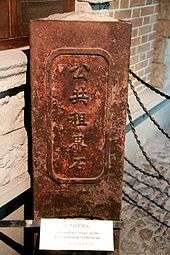Shanghai History Museum
Coordinates: 31°14′32.07″N 121°29′41.97″E / 31.2422417°N 121.4949917°E

The Shanghai History Museum (Chinese: 上海市历史博物馆; pinyin: Shànghǎi Shì Lìshǐ Bówùguǎn), also sometimes translated as "Shanghai Municipal History Museum", is a museum dedicated to the history of the city of Shanghai, China.
The museum's collections focuses on the approximately a hundred years in the history of Shanghai from the opening of the port in 1843 to the communist take-over in 1949.[1][2] The Shanghai Municipal History Museum currently has no permanent home, with much of its collection held in storage. However, part of the collection can be seen at its exhibition room at the base of the Oriental Pearl Tower in Lujiazui, in Pudong, and other parts of the collection can be seen on loan to other specialist museums in Shanghai. The museum also mounts temporary exhibitions at other venues, such as the Shanghai Library, from time to time.[1]
History
The Shanghai History Museum was established in 1983 as the "Shanghai History and Artefacts Exhibition Hall".[1] It first opened to the public on May 27, 1984 on the premises of the Shanghai Agriculture Exhibition.[1] The museum was moved to a new location (1286 Hong Qiao Road) and renamed to the "Shanghai History Museum" in 1991.[1] The main museum was closed due to land redevelopment in 1999, but "temporary" exhibitions of the museum's holdings continue to be mounted elsewhere. Since May 2001, the museum has maintained an exhibition room at the base of the Oriental Pearl Tower in Lujiazui, called the "Shanghai History and Development Exhibition", where select items from the museum's collection can be viewed by the public.[1]
Exhibits: Oriental Pearl Tower exhibition
The exhibits at the exhibition room at the Oriental Pearl Tower exhibition room is divided into five section titled: "Trace back to Huating", "Style and Features in the Town", "Sketch of the Port-opening", "Foreign Settlement", "Old footsteps in Shanghai".[1]
Collection

The collection of the Shanghai History Museum contains more than 30,000 items.[1] Of these, about 18,000 items pertain to the modern history of the city, a portion of these items found its way into the museum from the governors of the Foreign Concessions.[1] Notable items in the collection include:[1] Gu Embroidery of flowers, insects, and fish by the Ming-Dynasty "needle saint" Han Ximeng (韩希孟); a scroll by Hou Tongceng; the Golden Sutras of the Qi Bao Temple; a bronze cannon called "General Zhen Yuan" that once belonged to Chen Huacheng (1776–1842), a Qing Dynasty general responsible for Shanghai's defenses during the First Opium War; a "big hua qian" coin issued by the Taiping Heavenly Kingdom; a pair of bronze lions from the entrance of the former HSBC Building; and boundary markers from the French Concession and the Shanghai International Settlement (1893).
Location
The Shanghai History Museum currently has no permanent home. There have been repeated calls to rebuild a new building for the museum for many years, but commercial considerations (as the exhibition room at the Oriental Pearl Tower contributes to the commercial success of the tower as a tourist attraction) and budgetary constraints have prevented this from occurring. The municipal government has made repeated commitments to re-build the museum, but no rebuilding plan has been published. Most recently, the commitment to re-build the museum within five years was repeated during the 2011 municipal five-year plan.[1]
The main temporary exhibition room in the basement of the Oriental Pearl Tower. Other parts of the collection can be seen on loan to specialist museums within Shanghai. The museum also stages temporary exhibitions at other venues such as the Shanghai Library.
See also
References
Notes
Further reading
- Kirk A. Denton, Exhibiting the Past: Historical Memory and the Politics of Museums in Postsocialist China (University of Hawaii Press, 2014), pp. 88–92.
External links
- Official website (English)